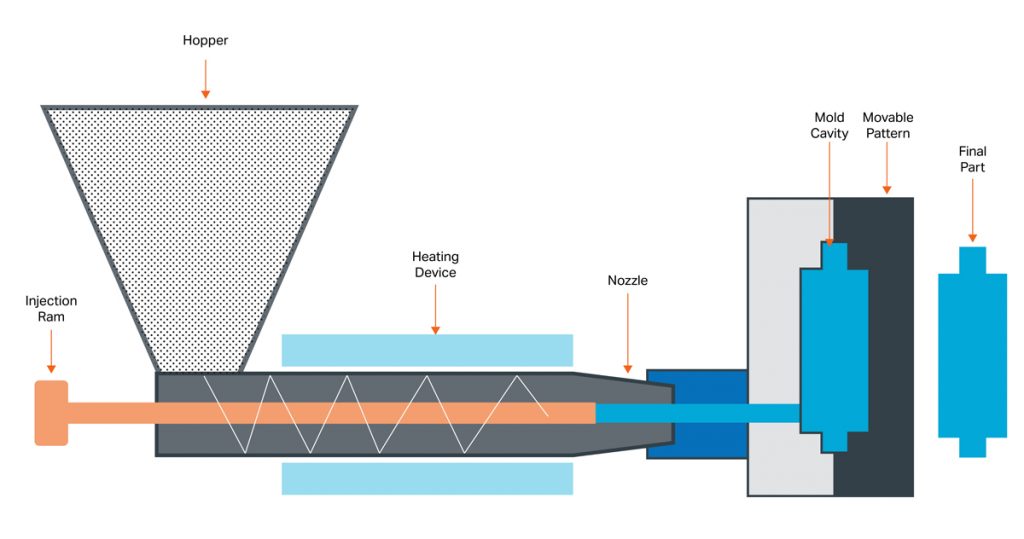Plastic Injection Molding

Key Factors in the Injection Molding Process
- Temperature Control: Precise control over the temperature of the material and the mold is crucial for maintaining consistency in the parts being produced.
- Pressure: High pressure is applied during the injection phase to ensure the molten material fills the entire mold and achieves the desired part dimensions.
- Cycle Time: The total time for each injection molding cycle—typically ranging from a few seconds to a couple of minutes—depends on factors like material, part size, and mold complexity.
Selecting the Right Plastic for Injection Molding
Choosing the ideal plastic for injection molding can be challenging due to the vast number of available options, each with distinct properties. Not all materials will meet the specific requirements of your project, but understanding the application and material characteristics can help narrow down the choices. Consider these key factors when selecting a material:
- Application Environment: Where will the part be used?
- Lifespan: How long does the part need to last?
- Stresses: What mechanical or environmental stresses will the part endure?
- Aesthetics vs. Performance: Is the appearance crucial, or is functionality the priority?
- Budget: What are the financial constraints?
Additionally, evaluate the material’s performance based on these characteristics:
- Mechanical and Chemical Properties: What strength, flexibility, or resistance to chemicals is required?
- Thermal Behavior: How does the material react to heat, including expansion, shrinkage, and melting temperature?
- Material Interactions: Will the plastic come into contact with air, chemicals, or other materials?
The complexity of the product design also influences material selection. For instance, parts with bendable sections or living hinges may require flexible plastics like polypropylene, while structural components exposed to harsh environments may benefit from durable options like PEEK or Nylon.
Below is a guide to common plastics used in injection molding, highlighting their benefits and industry applications.
| Material | General Industry Application | Advantages |
|---|---|---|
|
Polypropylene (PP) |
Commodity |
Chemical resistant, impact resistant, heat resistant, sturdy |
|
High-Density Polyethylene (HDPE) |
Commodity |
Chemical-resistant, impact-resistant, cold-resistant, and sturdy |
|
Polystyrene |
Commodity |
Impact-resistant, moisture-resistant, flexible |
|
Polyethylene (PE) |
Commodity |
Leach resistant, recyclable, flexible |
|
High Impact Polystyrene (HIPS) |
Commodity |
Cheap, easily formed, colorful, customizable |
|
Polyvinyl Chloride (PVC) |
Commodity |
Sturdy, impact-resistant, flame-resistant, insulative |
|
Acrylic (PMMA, Plexiglass, etc) |
Engineering |
Impregnable (glass, fiberglass, etc.), heat resistant, fatigue resistant |
|
Acrylonitrile Butadiene Styrene (ABS) |
Engineering |
Sturdy, temperature resistant, colorful, chemically safe |
|
Polycarbonate (PC) |
Engineering |
Impact-resistant, optically clear, temperature-resistant, dimensionally stable |
|
Nylon (PA) |
Engineering |
Impregnable (glass, fiberglass, etc.), heat resistant, fatigue resistant |
|
Polyurethane (TPU) |
Engineering |
Cold-resistant, abrasion-resistant, sturdy, good tensile strength |
|
Polyetherimide (PEI) |
Performance |
High strength, high rigidity, dimensionally stable, heat resistant |
|
Polyether Ether Ketone (PEEK) |
Performance |
Heat resistant, flame retardant, high strength, dimensionally stable |
|
Polyphenylene Sulfide (PPS) |
Performance |
Excellent overall resistance, flame retardant, harsh environment resistant |
Why Choose Injection Molding and ADDMAN?
Injection molding is the foundation for producing large volumes of high-precision, cost-effective parts that meet stringent quality requirements. Its ability to scale seamlessly while maintaining tight tolerances makes it indispensable for industries where consistency and performance are non-negotiable. At ADDMAN, we proudly offer our injection molding services from our HARBEC facility, a state-of-the-art manufacturing hub known for precision, sustainability, and innovation. With decades of experience in injection molding, HARBEC is equipped to handle the most complex projects, serving industries from medical devices to aerospace. Our team at HARBEC combines cutting-edge technology with a commitment to quality, ensuring that every part we produce meets the highest standards. When you choose ADDMAN, you’re not just getting a service—you’re gaining a partner dedicated to excellence and sustainability in manufacturing.